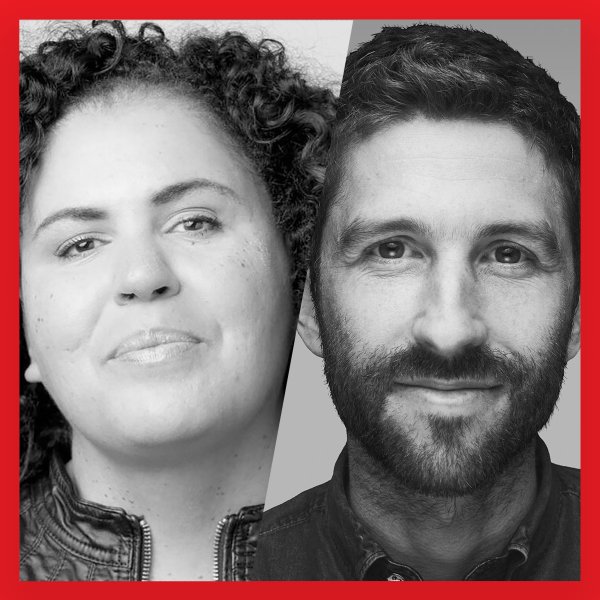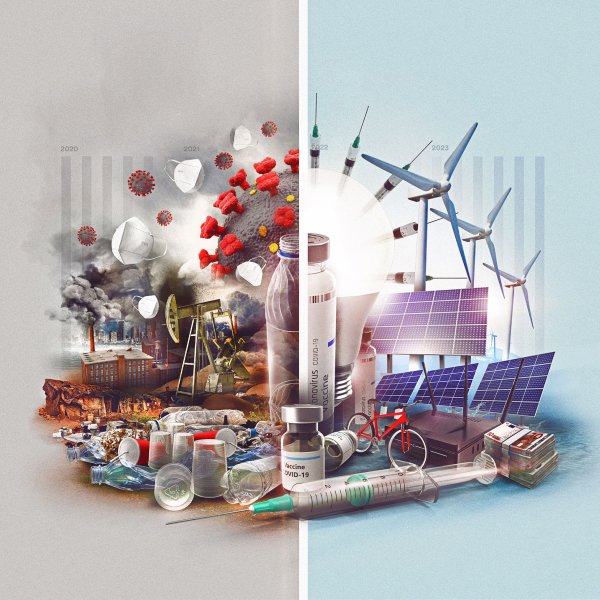Bjarke Ingels can sometimes sound like a mad scientist. “One thing I’ve learned a lot about over the past year is stone flour,” the 46-year-old Danish architect says over Zoom from his couch in Copenhagen. A mischievous smile spreads over Ingels’ tanned, boyish face as he explains: during the last ice age, glaciers ground rocks down into a fine, nutrient-rich substance, which stimulated flora and fauna in some parts of the world. Geologists are now investigating stone flour’s ability to bring life to infertile areas. “So say that in each container ship that sails across the oceans, you reserve four containers, fill them with stone flour and inject some when you cross a marine desert,” he says. As plants grow, they would draw down carbon from the atmosphere, reducing the greenhouse effect. “Then you can turn on the carbon-sucking capacity of the oceans.”
The outlandish scale of Ingels’ thinking won’t come as a surprise to anyone who’s followed his career. Over the past decade, Ingels has gone from the enfant terrible of architecture—known for head-turning innovations like a mountain-shaped apartment block or a pair of twisting towers in Miami—to one of the busiest architects in the world. Bjarke Ingels Group, fittingly known as BIG, has worked for high-profile companies like Google and WeWork, and has 21 projects under construction, from Ecuador to Germany to Singapore, with dozens more in the pipeline.
Ingels’ next project is a plan to save the world. When architects lay out a city block or a neighborhood, they often create a master plan: a document identifying the problems that need to be addressed, proposing solutions and creating an image of the future that all parties involved then work toward. In Masterplanet, BIG applies that thinking to the entire earth, laying out how we can redesign the planet to cut greenhouse emissions, protect resources and adapt to climate change. Stone flour may be one of the more left-field notions in the plan, but it will also fold in projects that are already under way. A few years from now, Ingels hopes, a newly installed Prime Minister or CEO might pull out Masterplanet when they want to address a climate issue within their remit, and see how to borrow from and add to global efforts.
Formulating a plan to fix climate change during your spare time may smack of hubris, if not megalomania. Climate-justice activists, who argue that climate action needs to address not only emissions but also systemic inequalities, question Ingels’ right to draft a plan for the entire planet, as well as his ability. Meanwhile, his fellow architects say the industry’s focus needs to be on tasks like improving the energy efficiency of buildings, not on flashy planetary vision boards. And even in a world where the COVID-19 pandemic has transformed our understanding of what is possible in terms of collective responses to a global challenge, it’s all but impossible to imagine any single climate plan achieving meaningful uptake from industries, governments and communities around the world.
For Ingels, though, none of that is a reason not to start one. Even when you’re making a master plan for a neighborhood, he says, it’s so large, it’s impossible to grasp at first. “But you go through iterations where you show it, you get a lot of feedback, and then you change it, until you tick all the boxes,” he says. “So even if in the beginning it seems so complex and so vast, eventually you get there.”
The architecture world has been called slow to respond to climate change. But over the past few years, architects, builders and designers have increasingly recognized the responsibility they bear: the construction and operation of buildings accounted for 39% of global energy-related CO2 emissions in 2018, according to a U.N. report. Prominent architects in the U.S. and the U.K. have signed a pledge declaring a climate emergency. Activist groups like the Europe-wide Architects Climate Action Network, launched last year, are pressuring architecture schools to make sustainability and resilience more central to curriculums and firms to implement best practices in the face of resistance from clients. In September, European Commission president Ursula von der Leyen announced the creation of a “new European Bauhaus”—evoking the influential 1920s design school—where architects and others will work on design solutions for climate problems “to give our systemic change its own distinct aesthetic.”
For architects, it won’t come as a surprise that Ingels has decided to strike out with his own bold climate plan. His buildings are famous for centering a single big headline-grabbing idea—a characteristic that led the Guardian’s architecture critic Oliver Wainwright to dub him “the undisputed king of the architectural one-liner” in a 2016 review of his installation—a curved wall made up of steps—at the Serpentine Gallery. The structure, Wainwright found, “provided gawp factor by the bucketload, but with some hiccups on closer inspection.”

That “gawp factor” has helped make Ingels’ buildings exceedingly popular. His most famous project may be CopenHill: a 279-ft.- tall power plant in the Danish capital, where trash is burned to generate low-carbon energy in a process so clean that BIG could place a ski slope on top. The building finally opened to the public in October 2019, with a positive reception from users and reviewers. Acknowledging the critique of Ingels’ work as “a bit flashy and a bit trashy,” the Observer’s Rowan Moore said the project lived up to the hype.
“This is a work well matched to its architects’ strengths. Nicety is not really the thing in this [old industrial area]; a compelling idea is. Plus a dollop of chutzpah.”
CopenHill embodied Ingels’ concept of “hedonistic sustainability,” laid out in a 2011 TED talk, which holds that reducing our environmental impact should also increase our quality of life, and that it’s designers’ jobs to make that calculation work. The approach has certainly appealed to clients. BIG has won a number of high-profile commissions centered on sustainability. In Manhattan, the firm is playing a key role in the construction of the Dryline, a park cum flood defense that will hug the island’s shoreline. In the foothills of Japan’s Mount Fuji, BIG is designing an entire town in partnership with Toyota, envisaged as a utopia for clean transport technology. Construction begins in 2021. On the late-summer day TIME spoke to Ingels, the state government in Penang, Malaysia, announced BIG as the winner of a competition to design a master plan to transform Penang Island’s south shore into a series of resilient artificial islands.
As the projects grew larger, Ingels says, so did his belief in the importance of scale when planning for a sustainable built environment. “When you’re building a house, there’s a few things you can do—add some solar panels on the roof and so on—but most of it is not very effective.” If you’re planning a city block or a neighborhood, though, you can start working with some “synergies,” he says: capturing rainwater over a large area; designing to take advantage of the differences in energy use between residential buildings, which typically spend energy on heating, and commercial buildings, which spend energy on cooling in the middle of the day. “There are all kinds of things you can start doing. And every time you go up in scale, you can actually do more.” The logical conclusion, he decided, was to attempt to tackle the entire world.
Masterplanet divides the world’s environmental problems into 10 sections. Five cover greenhouse-gas-emitting sectors—transport, energy, food, industry and waste management—and five cover other areas humans need to address to live sustainably on earth—biodiversity, water, pollution, health, and architecture and urbanism. The plan will initially take the form of conventional master-plan documents used by architects, “including budgets, area tables, system layouts and phasing strategies,” according to BIG. It will include ongoing projects, like the work of a plastic-recycling plant in the U.S., as well as more out-there ideas like creating floating cities to house communities affected by rising sea levels, or unifying global electrical grids to help solve the problems of “intermittency”—unreliable and inconsistent energy production by renewable sources, an obstacle to their wider adoption. BIG is consulting industry experts in energy, waste management, transport and other fields, before a first draft is made public in 2021.
By linking projects up in a single overarching plan, BIG says, it will “prove that a sustainable human presence on planet earth is attainable with existing technologies.” Masterplanet will account for 10 billion people—a figure we are due to hit not long after 2050—with the highest available living standards. Ingels says he wants both to galvanize businesses and governments to do more, and to change the way the public sees climate action. “I think a lot of people don’t really understand whether or not the different initiatives by different countries or different companies are adding up to something, whether or not it’s even possible to eliminate greenhouse-gas emissions or sequester carbon because of the complexity. So it ends up being a lot of opinions. And also a feeling of hopelessness,” he says. “That’s not the greatest call for action.”
Ingels says architects—whose daily work is turning requirements and feedback from an array of parties into built reality—have something unique to bring to the fight. Politicians are bogged down by short electoral cycles that don’t reward long-term planning. Activists are great at getting attention for issues but rarely have the power to enact their plans. Climate scientists are great at understanding problems. “But they are not entrepreneurs. Their specialty is not starting things up and making them happen.”
The practical barriers to the solutions proposed by Ingels are, of course, massive. For example, creating a unified global electrical grid could solve many problems, and make it more efficient and easier to power our world solely from renewable sources. But electricity-market experts say it’s almost too complicated to fathom doing so. Even a proposal to unite the main grids within the U.S. in 2018 was stifled by political pressure, according to reporting by the Atlantic.
But Edwin Heathcote, an architect and the architecture critic at the Financial Times, says Masterplanet fits into a history of “architects who set out a big idea as a provocation, more than a proposal.” He cites R. Buckminster Fuller, who appeared on TIME’s cover in 1964 with his plan to use giant geodesic domes, including one over Manhattan, as a way to building efficiently at a very large scale. The idea never came to pass. But it became “one of the most referred-to images in architecture” and fed into the Eden Project, a biological reserve in Cornwall, England. With architectural visions like this, Heathcote says, “the idea begins to pique people’s interests. It’s so kind of seemingly impossible that people begin to think, Well, actually, maybe there’s something in this. I think the idea of architecture as provocation is something that builds on Bjarke’s skill for presentation, his ability to synthesize big ideas for a broad audience.” As if to prove this point, BIG tells TIME it envisages Ingels hosting a 10-part documentary series, in the vein of Carl Sagan’s Cosmos, explaining the 10 sections of Masterplanet to the public.
“He has to say that he wants this to actually be realized,” Heathcote adds. “I’m sure he does. He would like to be, I’m sure, the man who saves the world.”
A master plan presumes authority. From the 17th century to the 20th, master plans were a key tool for European colonizers to create settlements in their empires in the Americas, Africa and Asia. More recently, within the U.S., master plans were at the heart of the midcentury projects for urban renewal, which resulted in the displacement of low-income residents and minority communities. For climate-justice activists, the idea of a 46-year-old white European man even suggesting a master plan for the planet is troubling.
“We are in the situation that we are in right now because of master plans coming out of Europe that have been responsible for extraction [of resources], enslavement and colonialism,” says Elizabeth Yeampierre, executive director of the New York City–based climate-justice organizing group Uprose. For her, the Masterplanet idea is “brimming with hubris” and an “outdated approach” to solving the climate crisis.
Yeampierre argues that people from the Global South and communities of color in the Global North, who will be disproportionately impacted by the physical and economic harms of climate change, should not just be consulted on plans to address climate change but should also be the ones to originate them. “So far we have moved the dial on addressing climate change slowly, because deference has always been given to people with privilege as the drivers of solutions.”
Ingels, whose firm has mostly worked in Europe and the U.S. and has mostly white male partners, says he’s aware that attempting this project will attract “all kinds of criticism.” He’s keen to stress that BIG “has no authority whatsoever over the planet.” He doesn’t want his firm to be in charge of redesigning the earth but “to get the ball rolling and see if we can get more people involved.” “We believe it could be a useful tool to accumulate initiatives in a practical, pragmatic way. And instead of complaining about why no one is doing it, we thought, O.K., let’s just start doing it. It’ll only have an impact if enough relevant entities think it’s useful and want to contribute and collaborate and criticize.”
Billy Fleming, director of the McHarg Center at the University of Pennsylvania Stuart Weitzman School of Design, who leads projects to redesign urban space to improve sustainability and quality of life, says the central goal of Masterplanet—to create a unified plan for a sustainable planet—is not a bad one. “I think a plan created through consensus is something that folks involved in the U.N. Environmental Programme would like to get to and never do, for all kinds of reasons.” But BIG is not an appropriate body to lead such action, he says. “Making images of the future can and often does prefigure it. And doing that comes with a real responsibility to the people whose lives will be transformed by the future these images can prefigure. And as a design firm that—in Bjarke’s telling in [public speeches]— is very disinterested in any kind of political questions, they’re not accountable to anyone or any community.”
Ingels’ approach to politics has sometimes made him an uncomfortable ally for progressives. In January, while on a research trip to Brazil for luxury-ecotourism firm Nomade, Ingels posed for a photo during a meeting with the country’s far-right President Jair Bolsonaro. Social media filled with criticism of Ingels for taking a meeting with a man who has rolled back protections for Indigenous communities and fiercely encouraged deforestation in the Amazon. In a statement, Ingels called the criticism “an oversimplification of a complex world.” “As much as I would enjoy working in a bubble where everybody agrees with me, the places that can really benefit from our involvement are the places that are further from the ideals that we already hold.”
Ingels doesn’t like to associate himself with any particular ideology or political project. But he says Scandinavian-style social democracy has some clear advantages. He and his family normally spend their time in New York, but shortly after the COVID-19 pandemic hit the city in March, they moved back to Copenhagen for a while. “It seems like a welfare state is maybe better equipped,” he says with a smile. “You know, equity is a good thing in times of crisis: public health care, social security and free education—it works well!”
He does not look to the state to play the largest role on climate, however. He says the climate-change challenge must be met primarily by private businesses. As an architect, he says, he’s learned that “anything that’s entirely relying on public spending is dependent on funding. And when the funding runs out, you have to raise more. If you can make things both environmentally and economically profitable, they become self-scaling.” The state’s primary role in the climate-change fight, he says, should be “to eliminate the barriers that have been implemented over time,” including “various kinds of trade barriers” in sectors like energy. “The environment doesn’t care about party politics or about outdated ideologies, for that matter.”
That brand of pragmatism often puts Ingels at odds with climate activists, including those within his industry. Among architects, the question of whether or not those who care about sustainability should accept commissions for airports has become a major point of debate. Would Ingels build an airport? “Definitely,” he says, adding that BIG would then use the best available strategies to make operations more sustainable. “I mean, would you refuse to fly? Should the whole world stop flying? So if we agree that sometimes it’s necessary to jump on a plane, then let’s make it happen.”
A few days before TIME spoke with Ingels, an education initiative in Denmark asked him for some help creating classes for high schoolers. The request made him think of his own student days, and he pulled out the thesis that he, like all Danish teenagers, wrote at the end of high school, at age 19: “Environmental Policy on Global, Regional, National, Local and Individual Level: A Follow-Up on the Rio Conference.” The title, which refers to a 1992 U.N. summit, was, he admits, “not so catchy.” But he got the top grade.
The world into which BIG is releasing Masterplanet is unrecognizable from the one where Ingels was writing in 1993, or even the one where he began thinking about this idea in spring of last year. For one thing, yearly global CO2 emissions have risen by more than 60% since 1990, and we are perilously close to reaching a catastrophic average global temperature rise of more than 1.5°C over the preindustrial era. For another, the pandemic has forced countries to shutter economies and inject unprecedented sums of public money to keep society afloat. Like many, Ingels sees a sign of hope there for climate action. “If we could apply a similar decisiveness toward the climate crisis, I think we could deal with it much more impactfully and much quicker than we imagine possible today.”
Whether Masterplanet is the basis for that decisive action or not, Ingels says his 19-year-old self would be pleased with the bold action he is taking. Twenty-seven years later, preparing his next environmental project, he’s definitely gotten better at titles. The grade is still pending.
With reporting by Madeline Roache
Correction, Oct. 22
The original version of this story mischaracterized an interaction between Bjarke Ingels and Brazilian President Jair Bolsonaro. Ingels did not work directly with Bolsonaro, but did take a meeting with him.
- Cybersecurity Experts Are Sounding the Alarm on DOGE
- Meet the 2025 Women of the Year
- The Harsh Truth About Disability Inclusion
- Why Do More Young Adults Have Cancer?
- Colman Domingo Leads With Radical Love
- How to Get Better at Doing Things Alone
- Michelle Zauner Stares Down the Darkness






